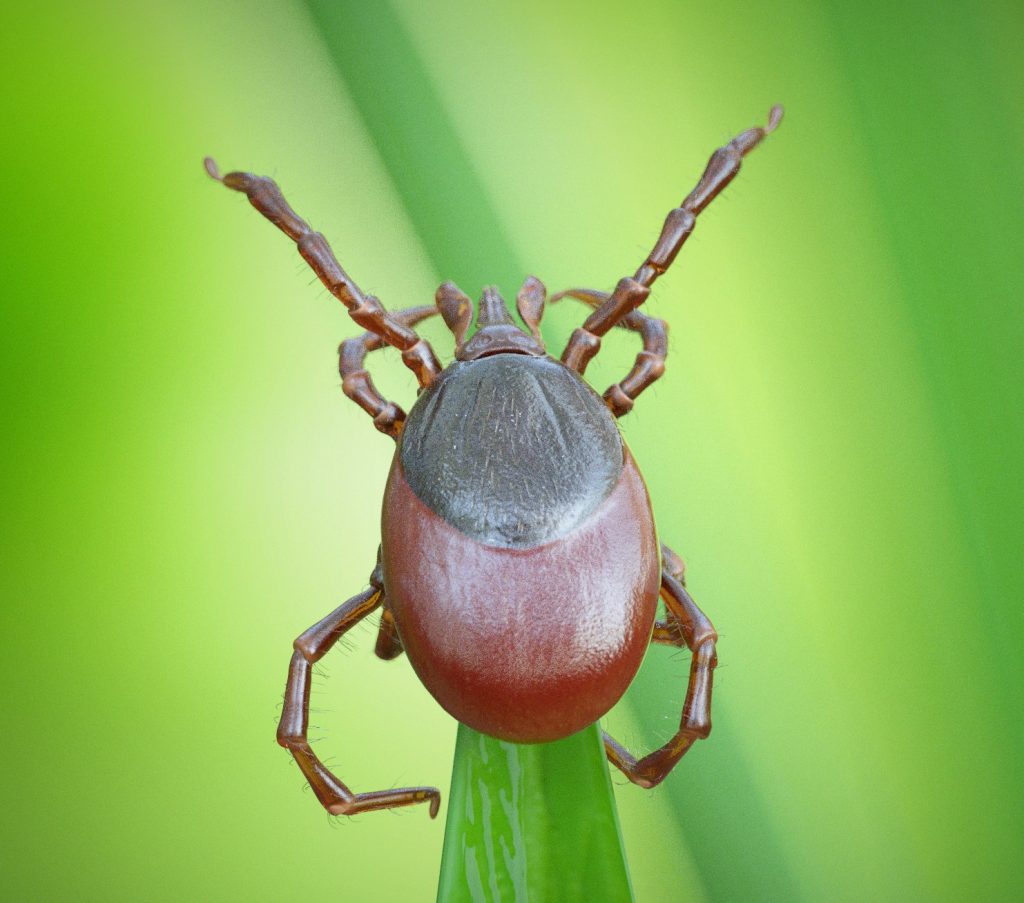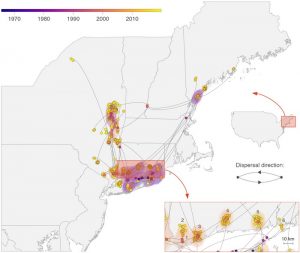New England’s concentrated clusters of tick-borne Powassan virus

By Jenny Blair, Yale School of Public Health
A new study by investigators with the Yale School of Public Health (YSPH) finds that the tick-borne Powassan virus is being transmitted in concentrated community clusters throughout New England.
The findings could help local health officials focus their efforts in eradicating the Powassan virus and preventing Powassan infections.
There are currently no vaccines or treatments for Powassan virus infection. Prevention is primarily dependent on education and control. Most people infected with Powassan do not experience symptoms, but for some, it can result in brain swelling and even death.
“It’s incredibly important to do surveillance to know what’s out there,” said Chantal Vogels, a research scientist in the Department of Epidemiology of Microbial Diseases at YSPH and a co-first author of the study.
By greatly expanding on what little genomic information scientists had before our study, Vogels said, “we were able to explore patterns of transmission and spread and unravel the ecology of the virus.”
As part of their investigation, the researchers studied 279 samples of Powassan virus lineage 2 found in deer ticks (Ixodes scapularis, also called black-legged ticks) collected in Connecticut, New York, and Maine between 2008 and 2019.
Deciphering the genetic code
By deciphering and comparing the virus’s complete genetic codes, or genomes, the researchers reconstructed the history of Powassan in the region. They estimated when branches of the virus’s “family tree” diverged and pieced together how the virus evolved and where it traveled via its hosts.
They found that sometime between 1940 and 1975, a major branch of the lineage 2 virus appeared in the Northeast. This branch of the virus, which accounts for most Powassan cases in North America, first appeared in southern New York State and Connecticut.
Then, several long-distance jumps occurred, likely when infected ticks caught rides on migrating birds or other vertebrate hosts. By 1991, it had reached Maine. During its initial decades in the region, Powassan became more populous in the wild, but this probably leveled off about 2005.
Hotspots

Reconstruction of the dispersal history of Powassan virus lineage 2 viruses inferred by a spatially-explicit phylogeographic analysis. The highly focal distribution of the virus, with rare long-distance dispersal events, is particularly clear in Connecticut (see zoomed inset). Besides a single dispersal event between locations 1 (Westport) and 2 (Redding), the researchers did not observe mixing between the 5 distinct locations in Connecticut.
CREDIT: Chantal Vogels
The virus now appears to be moving slowly or staying put, simmering in specific hotspots, and evolving independently in each one.
For instance, the scientists could find no evidence that separate clades of the virus were mingling with each other across a 20-kilometer (or approximately 12.5 miles) stretch between two Connecticut sites. [Editor’s note: A clade is a group of organisms that includes a single ancestor and all of its descendents.] The scientists note however that they sampled only a limited number of locations, so it’s possible they missed hotspots.
Still, this new information could help health officials to target hotspots — where Powassan is more likely to spill over into humans — for education and eradication efforts. In addition to New England, the virus has also been reported in high numbers in the Great Lakes region.
“If it’s anything like the related tick-borne encephalitis virus, previous researchers have estimated that these foci are typically about the size of a football field,” said Doug Brackney, a researcher in the Department of Entomology at The Connecticut Agricultural Experiment Station and an assistant clinical professor in the Department of Epidemiology of Microbial Diseases at YSPH.
Few cases diagnosed until 2006
The Powassan virus is so named because the virus was first identified in a five-year-old boy from Powassan, Ontario, who developed severe encephalitis and died in 1958. After that, about one case per year was diagnosed until 2006. Then cases began to climb, and since the late 2010s dozens of diagnoses have been made nearly every year.
The Yale study appears online in Proceedings of the National Academy of Sciences.
The research was funded by the National Center for Advancing Translational Science, a component of the National Institutes of Health (NIH); the National Institute of Allergy and Infectious Diseases of the NIH; Internal Funds KU Leuven; Research Foundation – Flanders; Fonds National de la Recherche Scientifique; and European Union Horizon 2020.
Given that the virus’s numbers appear to have leveled off in the wild, this increase in human disease may have happened because more humans are encountering ticks, and/or because more health professionals are checking for Powassan in patients with suspicious symptoms.
Unlike Lyme disease, which takes hours to pass from an infected tick to a human, Powassan can be transmitted just 15 minutes after the tick latches on. More New England residents have likely been infected with Powassan than have shown symptoms.
“We typically only see the most severe cases of disease, and those are the people that end up in the hospital. But it’s probably just the tip of the iceberg,” Vogels said.
“I think it’s really important to be early with this work,” she added, “to prevent a situation where everyone has heard of this virus, and it creates a huge burden on public health.”
SOURCE OF PRESS RELEASE: Yale School of Public Health




















We invite you to comment on our Facebook page.
Visit LymeDisease.org Facebook Page